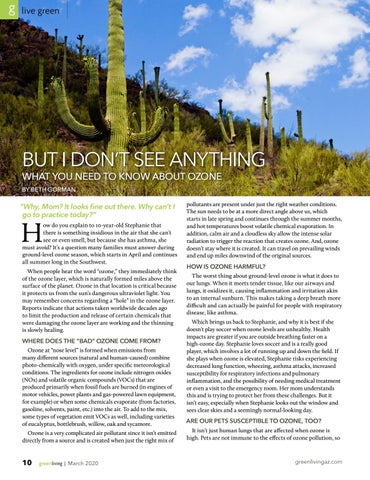BUT I DON’T SEE ANYTHING WHAT YOU NEED TO KNOW ABOUT OZONE BY BETH GORMAN
“Why, Mom? It looks fine out there. Why can’t I go to practice today?”
H
ow do you explain to 10-year-old Stephanie that there is something insidious in the air that she can’t see or even smell, but because she has asthma, she must avoid? It’s a question many families must answer during ground-level ozone season, which starts in April and continues all summer long in the Southwest.
When people hear the word “ozone,” they immediately think of the ozone layer, which is naturally formed miles above the surface of the planet. Ozone in that location is critical because it protects us from the sun’s dangerous ultraviolet light. You may remember concerns regarding a “hole” in the ozone layer. Reports indicate that actions taken worldwide decades ago to limit the production and release of certain chemicals that were damaging the ozone layer are working and the thinning is slowly healing.
WHERE DOES THE “BAD” OZONE COME FROM? Ozone at “nose level” is formed when emissions from many different sources (natural and human-caused) combine photo-chemically with oxygen, under specific meteorological conditions. The ingredients for ozone include nitrogen oxides (NOx) and volatile organic compounds (VOCs) that are produced primarily when fossil fuels are burned (in engines of motor vehicles, power plants and gas-powered lawn equipment, for example) or when some chemicals evaporate (from factories, gasoline, solvents, paint, etc.) into the air. To add to the mix, some types of vegetation emit VOCs as well, including varieties of eucalyptus, bottlebrush, willow, oak and sycamore. Ozone is a very complicated air pollutant since it isn’t emitted directly from a source and is created when just the right mix of
10
greenliving | March 2020
pollutants are present under just the right weather conditions. The sun needs to be at a more direct angle above us, which starts in late spring and continues through the summer months, and hot temperatures boost volatile chemical evaporation. In addition, calm air and a cloudless sky allow the intense solar radiation to trigger the reaction that creates ozone. And, ozone doesn’t stay where it is created. It can travel on prevailing winds and end up miles downwind of the original sources.
HOW IS OZONE HARMFUL? The worst thing about ground-level ozone is what it does to our lungs. When it meets tender tissue, like our airways and lungs, it oxidizes it, causing inflammation and irritation akin to an internal sunburn. This makes taking a deep breath more difficult and can actually be painful for people with respiratory disease, like asthma. Which brings us back to Stephanie, and why it is best if she doesn’t play soccer when ozone levels are unhealthy. Health impacts are greater if you are outside breathing faster on a high-ozone day. Stephanie loves soccer and is a really good player, which involves a lot of running up and down the field. If she plays when ozone is elevated, Stephanie risks experiencing decreased lung function, wheezing, asthma attacks, increased susceptibility for respiratory infections and pulmonary inflammation, and the possibility of needing medical treatment or even a visit to the emergency room. Her mom understands this and is trying to protect her from these challenges. But it isn’t easy, especially when Stephanie looks out the window and sees clear skies and a seemingly normal-looking day.
ARE OUR PETS SUSCEPTIBLE TO OZONE, TOO? It isn’t just human lungs that are affected when ozone is high. Pets are not immune to the effects of ozone pollution, so
greenlivingaz.com

















